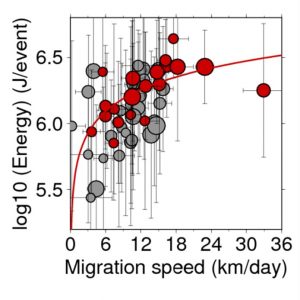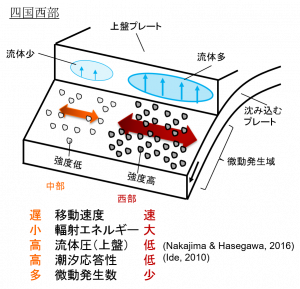Masayuki Kano1 2, Aitaro Kato2, Ryosuke Ando3 & Kazushige Obara2
1Department of Geophysics, Graduate School of Science, Tohoku University, Sendai, Japan 2.Earthquake Research Institute, The University of Tokyo, Tokyo, Japan
3.Department of Earth and Planetary Science, The University of Tokyo, Tokyo, Japan
Scientific Reports, vol. 8, 3655 (2018), doi:10.1038/s41598-018-22048-8
Deep low frequency tremors are indicators of slow slip transients in the brittle-ductile transition zone along subducting plates. Investigation of comprehensive tremor activities is therefore an important issue for understanding the seismic/aseismic characteristics in transition zones. Here, we focus on the radiated energy from tremors to reveal the along-strike heterogeneity in the strength of tremor patches. Based on a tremor catalog that more accurately evaluates radiated energy, we examine the spatio-temporal activity of tremors accompanied by slow slip events (SSEs) in western Shikoku, southwestern Japan. The new finding of this study is that the energy radiated from tremors is positively correlated with the speed of tremor migration front and the slip rate along the plate interface during a SSE. This can be qualitatively explained by a stress diffusion model, which consists of along-strike heterogeneities in the effective strength of tremor patches embedded in a ductile shear zone. This effective strength heterogeneity is supported by a lateral variation in the stress drop of a SSE; it is consistent with the fluid pressure distribution along the plate boundary fault and the tidal sensitivity of tremors. Accurate evaluation of tremor activities, especially the radiated energy, can be used to infer the spatial distribution of the strength of tremor patches in transition zones worldwide.




